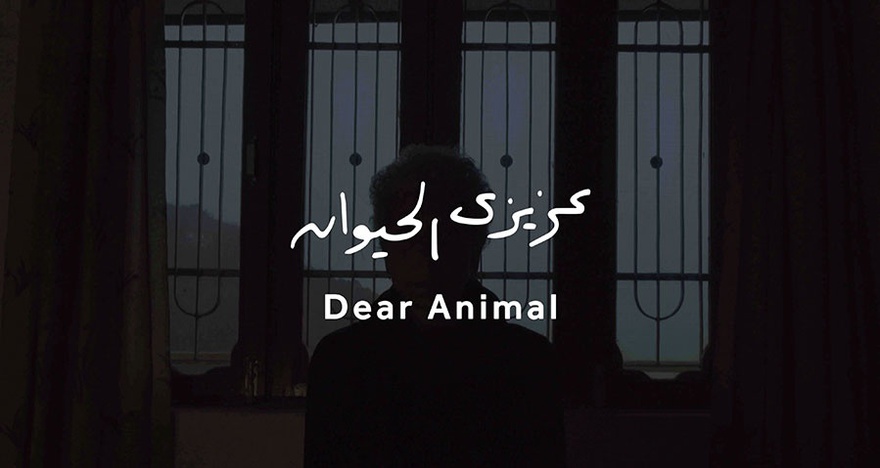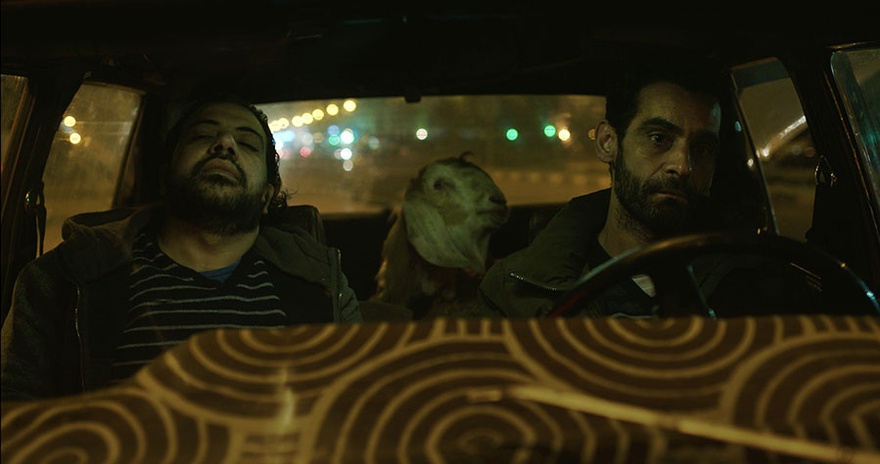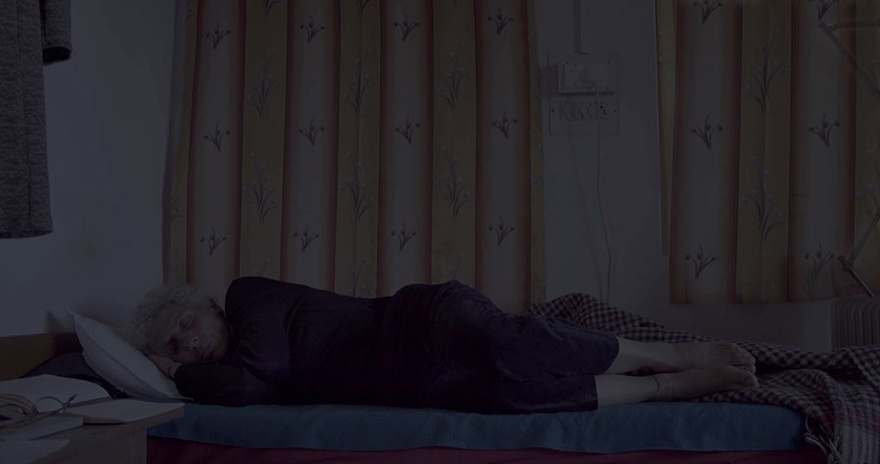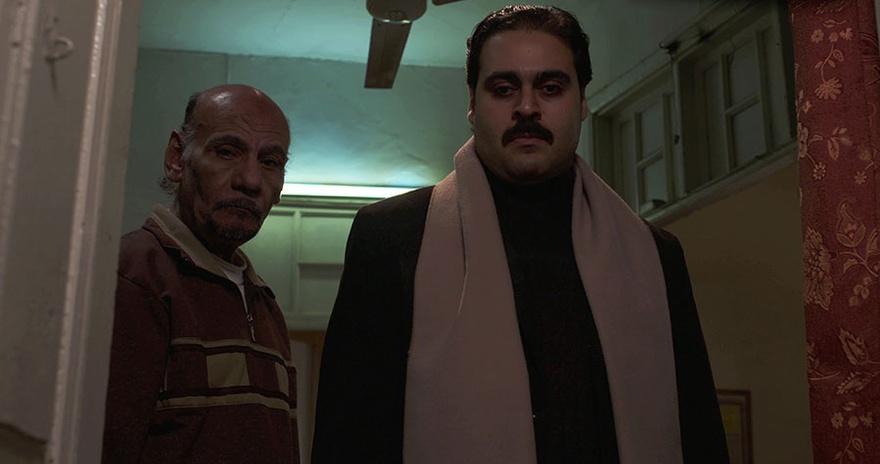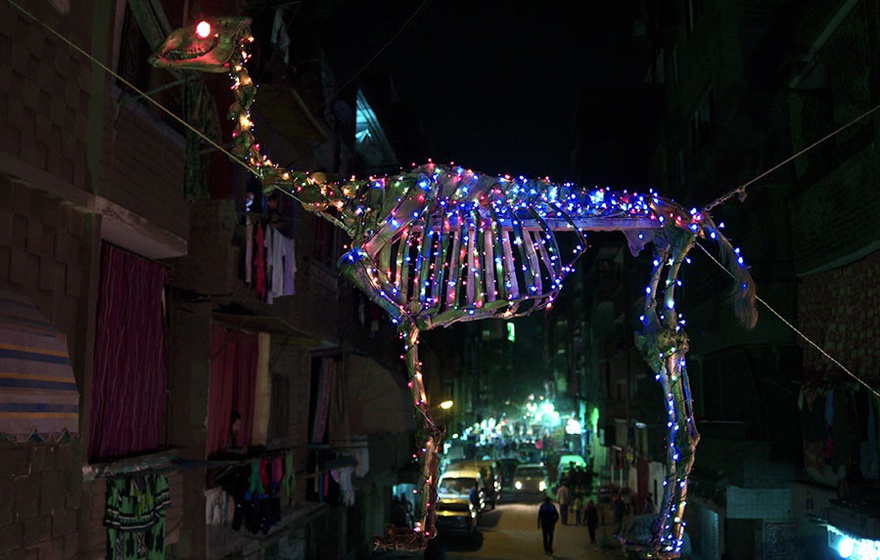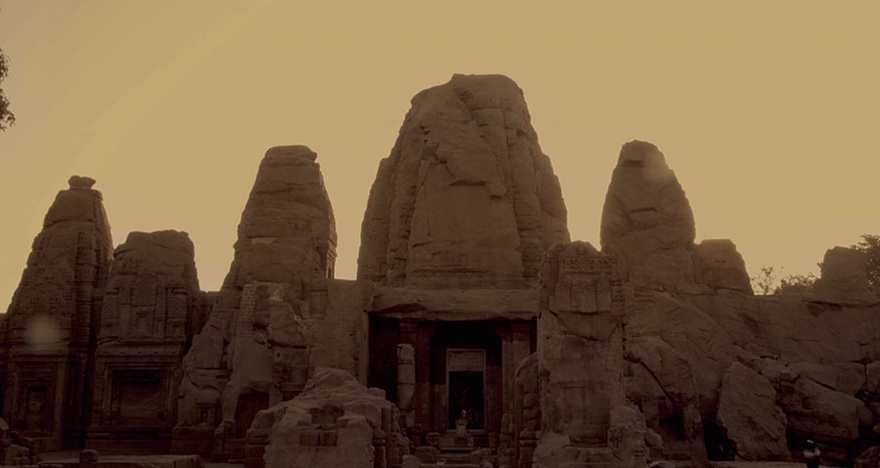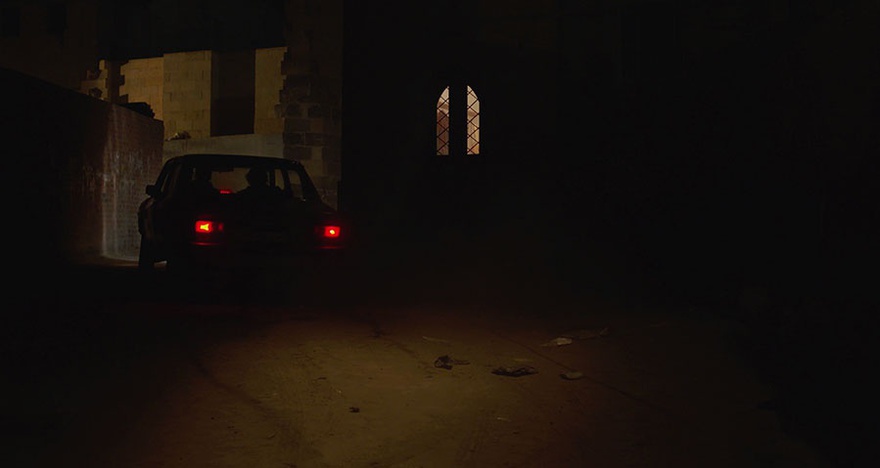Essays
Dear Animal
Notes in a Conversation on a Film by Maha Maamoun
I.
It was related to me that in a farm on the outskirts of Cairo lives a billy goat, which resembles a zebra with 'short strong legs, wide stout neck, and fine black stripes crossing his body'. If goats had any memory for names, this one would respond to Walid Taha.
Before life on the farm, before the acquired stripes and the bestowed name, the goat most probably lived the average life of an urbanized animal for years. Eating and drinking from the waste of humans and the provisions of the land, it might have even enrolled in a couple of financial trades, shifting owners and shifting mates.
Yet, none of these experiences could have prepared it for the moment it stood in front of a camera to embody the role of a shapeshifting drug dealer in Maha Maamoun's latest work Dear Animal, 25-minute film that interweaves scenes inspired by Haytham El-Wardany's short story 'Sultan Qanun al-Wujud' (Lord of the Order of Existence), and the notes Azza Shaaban has irregularly posted on her Facebook wall since leaving Egypt in 2013.
II. Haytham El-Wardany
…Yet in short stories, it's not the force of construction that is at play. There is a different force that aims to stretch what already exists to its extreme limits. A force that seeks a fragile balance in the moment of collapse. Such force has no control over its subject, for it functions over a gaseous state of matter. From that perspective, the story resembles a poem, for both of them perceive a hallucinatory viewpoint towards the gravity of the real. At this point, novelistic structures disappear in favor of prosaic threads. Here erupts the cosmic dust and shine the stars in the sky.[1]
It's specifically this instinctive force at play, at that moment of collapse, that acts as a key to unlocking the multilayered tale of Sultan Qanun al-Wujud; the story of a ring of drug dealers who find themselves in a curious situation when one of them, Walid Taha, who has stashed their latest consignment of drugs, inexplicably turns into a hybrid animal: a curious amalgamation of goat and zebra. The storyline follows their desperate attempts to get any word out of him as to the whereabouts of the drugs. More importantly for their boss, however, is to set an example out of Taha so that no one tries this trick again. Order must be kept and business must be protected.
The underworld laid out in Wardany's story seems as complex as it is callous; too callous that when faced with the sudden transformation of the drug pusher, the only conceivable reactions from the parties involved, on either side of the law, are along the lines of either total engulfment or total annihilation. Amid the conflict between two generations of drug dealers, and their attempts to approach the problem at hand, a devolution is highlighted. The story that initially lends itself to a heritage of surreal metamorphosis quickly reveals inherent remarks on the codes of a certain subculture, and questions how much moments of transition can reveal about power structures.
In his text 'How to read Kalila wa Dimna', Abdelfattah Kilito bluntly states: '…Narrative is the weapon of the defenseless'.[2] The statement is driven by his remark that in the frame tale – full of talking animals, usually arguing and negotiating – the lion is the least talkative.[3] For one, the lion's paws are mightier than any argument, but more notably, the power of his words comes from their scarcity. Withdrawal requires and implies strength. The dramatic conflict in the fictional half of Dear Animal instantly surpasses the metamorphosis to centre around the mundane effect of the withdrawal of Walid Taha's speech abilities as a man turned animal, or rather the critical timing of it.
III. Azza Shaaban
For as long as I can remember, I've always known I was a dolphin, and recalled events from my previous life.[4]
Taking her cue from the Rabaa massacre in August 2013, Azza Shaaban embarked on an open-ended trip to India. The idea of leaving Egypt had already been brewing in the minds of many Egyptians by that time, especially those who saw bloodshed of friends and fellow protesters on the streets of Cairo from 2011 onwards, as they slowly realized that the last blood was yet to come. Shaaban's exit to seek healing for physical and psychosomatic maladies led her to the foothills of the Himalayas, where she started a process of unloading and disentangling. Despite the extreme distance she took, or maybe as a result of feelings synonymous with such displacements, Shaaban soon felt an urge to maintain a channel of communication with Cairo, and she found it in the form of open letters that she posted irregularly yet frequently on Facebook. In these ongoing letters, which always begin with 'Dear Animal', and end with 'Signed: The Dolphin', Azza Shaaban is speaking in the first animal already. She/The Dolphin addresses her friends in Cairo, 'the animals', through the digital forest of Facebook, sharing her present state of mind and body, and sometimes hinting at shared, scarring memories.
Much like Wardany's protagonist, Maamoun's film took to hybridity itself. If Sultan Qanun al-Wujud explores the elementary particles connecting the atoms and molecules of a certain power structure, the film's other half, Shaaban's Facebook notes, occupy another state of 'matter': a post-apocalyptic state where ambiguity is the rule, and where classic boundaries of space, time, gender and species give way to moments of interplay and contemplation.
IV. Maha Maamoun
In the couple of years following the 2011 Egyptian revolution, I noticed a rise in the appearance of animals in the writings of people around me. Has this always been the case but I just noticed it then? I started looking and finding more animals, animal news and analogies appearing in the news, talk shows, opinion pieces, literary texts and art projects. Possibly an attempt to revise, or conversely to re-assert, the status-quo and its catastrophic power relations. In this film, I focused on two significant pieces of writing from that period in which animals curiously appeared, not as metaphors, symbols or prosthetic tongues for an endangered political subject, but as indeterminate shifting forms with uncertain beginnings and ends.[5]
As opposed to classical views of animals as creatures that 'do not know what is meant by yesterday or today', 'leap about, eat, rest, digest, leap about again', and 'from morning till night and from day to day' – 'fettered to the moment and its pleasure or displeasure' – are 'neither melancholy nor bored', the dolphin Azza Shaaban evokes is granted voice, memories, a present and future.[6]
In one scene, over images shot by Maamoun herself of Shaaban's balcony overlooking the serene forests of Dharamsala, Shaaban's voiceover describes her daily life in India, and how she's treading roads shared by humans, animals, birds and cars. The redemption of the dolphin in Shaaban's narrative opens up a new potential in her present moment. In signing out of restrictive, linear, hu(man)-centric narratives of history, an animal persona/pen-name harps on an animalistic historic ambivalence and allows for the writing of an alternative history.
Maamoun's film, as opposed to her previous video and photography work, primarily raises the question of the viability of narrative vehicles to map out metaphysical/mystical concepts often inhabited by theology, mythology or niche philosophy. How far can the emotional embodiment of thoughts – and the banking on the heritage of dramatic representations and melodramatic gestures – relate to concepts tackling the boundaries of form?
These questions are partly addressed in the very structure of the film. The steady intercutting between the documentary-like footage of Dharamsala and the fictional scenes shot in Cairo impels an internal dynamic; one that threads lines of divergence and convergence, alternatively opening up channels between two regimes that are otherwise separated. This is a concept that shares some lineage with early Soviet theoretical approaches to film and montage, where images are edited in a dialectical structure that propels a chain reaction of feelings and meanings, and notions run in parallel like train rails, projecting an imaginary meeting point on a virtual horizon in the viewer's eyes.
The investment in maintaining the vague connections within the film proves essential to the breathability of its own fabric. The entanglement points to the film's dual parts and instigates feedback loops between them. The muteness of Walid Taha/the zebroid goat is faced by the first-person voice of Shaaban; her addressing of Cairo and the past from her nonhierarchical, anachronistic perspective brings a new individualistic angle to an inherently collective experience of history.
Such an angle resists the rigid flow governed by progress, which in turns highlights the gravity of Walid Taha's individual withdrawal, and the risk this withdrawal poses on the credibility and survival of the cemented rules of existence governing the world he belonged to.
V. Maha Maamoun
I came across the hanging camel skeleton that appears in the film by chance – in a picture taken and posted by Mahmoud Khattab on his Facebook page. When asked by the stunned viewers about the whereabouts of this thing, he shared the address of the butcher's shop. Apparently a butcher in Eastern Cairo, who sells camel and other meat, reassembled a camel's skeleton, decorated it with colorful blinking lights and hung it in front of his shop as a sign. It hovers high above a constant stream of people and vehicles passing through the long narrow street that is lined on either side by residential buildings and shops to which the hanging skeleton is attached and from which it draws its electrical life-force. I was struck by this image and struck even more upon encountering the thing itself. Turning a corner and seeing it in situ, hanging above a busy residential area like any other casual decoration, gave me goosebumps. It's both morbid and fun, but maybe its impact is in its unfamiliarity. It's not a traditional, local, familiar object or aesthetic. Again, it felt like another instance where a yet unidentifiable fluid flux of thought and feeling is finding form. Here again via the animal. It's still hard for me to understand this thing and what it expresses. And though it appears in passing in one scene of Dear Animal, for me it was like a third text informing the film.[7]
Despite their differences in terms of form and aesthetics, the roots of the two halves of Dear Animal share a primitive space of ambiguity that resists metaphors: a space where people are not just people and animals are not completely animals, but both are not yet something else in particular.
That middle space of perpetual flux traverses the three-dimensional world of narrative towards a fourth one, not very different from the realm where mythology draws its force. In the landscape of a myth, historical truth is meaningless, and the categorization of fiction and reality is suspended. It's this ahistorical space, where forms, identities and concepts escape the gravity of narratives and gain more permeability. Here, they are allowed to reconnect to forgotten origins and foundations that give myth its overarching quality.
While for most of the time we lie at the consuming end of mythology, we indeed do provide it with meaning. As Jean Luc-Nancy noted, 'we know that although we did not invent the stories (here again, up to a certain point), we did on the other hand invent the function of the myths that these stories recount…'[8] Perhaps the most stimulating notion in Dear Animal is the attempt to re-question that portal, and to hack this mythical origin space, reactivating an atrophied lane in the two-way road between the storyteller and the audience. In Dear Animal, the viewer's automatic urge to connect the dots between the two stories reflects something in us, and the film's self-awareness of the distance it keeps summons the possibility of a collective, active and imaginative space.
VI. Azza Shaaban
I imagine the reason behind my reconnection to my animal past has to do with my perception of time. I've always mistaken events from the past to be in the future, and vice versa.[9]
In the thirteenth century, when the grand sheikh of Sufism wanted to attest to signs of his early sainthood, he brought a herd of zebras to act as witnesses. The story in the Meccan Revelations tells of an incident where the adolescent Ibn Arabi – still then in what he dubs as his jahiliyya phase – rides a horse in a travelling caravan across al-Andalus alongside his father and a group of guards. As the caravan approached a group of feeding wild zebras, which the armed troupe was bound to disturb, Ibn Arabi, who was ahead of the caravan, believed in his heart that he would not be of harm to them. So he passed through, his spear almost touching their napes, and the zebras did not even look up. It was only when the rest of the caravan arrived that the herd flinched and dispersed.
One way of reading this incident would be that to the zebras, Ibn Arabi was not identified as an-other; his own subjectivity expanded to intertwine with that of the other creatures and components of the cosmos, rendering conflict obsolete. Another possibility would be that between his ideas of space-time, and between the animals' alleged ambivalence towards the flow of history, Ibn Arabi was, from a certain perspective, invisible: in the time, but not of it.
The idea of a traversing, fluid subjectivity is tangible in the choices made in the making of Dear Animal. In the joint between the voice and the voiceless, the present and the withdrawn, we are urged not only to surpass dichotomies, but to also question the idea of subjectivity altogether. A proposition mediated not by our accumulated knowledge of boundaries, but rather through a revisiting of the very structure of our perception.
VII. Haytham El-Wardany
It's not just a one-way interaction, I imagine that animals have their own agency, and at some points they can recall themselves into our reality...it's not a realm that can be exclusively explained via the rules of causality.[10]
Somewhere on the outskirts of Cairo, in a farm near the pyramids of Abu Sir, lives a goat with faded paint patterns on its body that might still respond to the name Walid. Legend has it that on one night, the goat will have a dream about aquatic mammals, mind-altering substances, revolutionaries and humans in a dark room watching projected light. The goat will wake up confused and go silent for a certain period, after which he might speak his real name.
[2] عبد الفتاح كيليطو (2009). من شرفة ابن رشد. دار توبقال للنشر. (ص 6
[4] As quoted in a conversation with the author on a Zamalek Balcony, September 2016.
[5] As quoted in a Skype conversation with the author, September 2016.
[6] Friedrich Nietzsche, (tr.) R. J. Hollingdale, Untimely Meditations (Cambridge: Cambridge University Press, 1997), p. 60.
[7] As quoted in a Skype Conversation with the author, September 2016.
[8] Jean-Luc Nancy, The Inoperative Community (Minneapolis, MN: University of Minnesota Press, 1991), p. 45.
[9] As quoted in a conversation with the author on a Zamalek Balcony, September 2016.
[10] As quoted in a Skype conversation with the author, September 2016.

